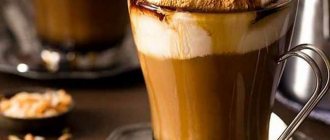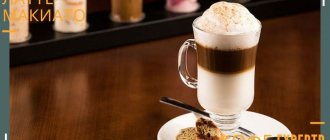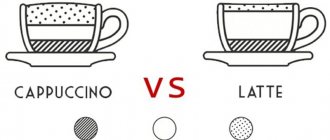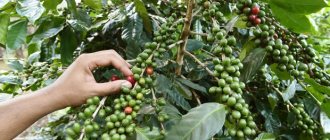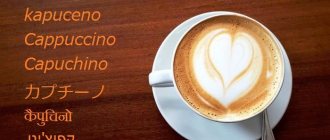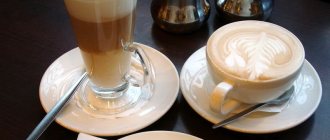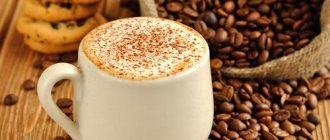Origin of coffee
Both drinks were invented in Italy.
It’s worth starting with the fact that all the similarities of this pair end with their origin and the ingredients from which they are prepared. Both the first and second come from Italy. Latte is a simplified version of coffee latte, which translates from Italian as “coffee with milk.”
The word cappuccino comes from the Capuchin order, which had a red-brown emblem. The drink was very similar in color to the banner, which is how the world-famous name Cappuccino was assigned to it.
Properties, features, differences between latte coffee
Latte macchiato, when properly prepared, is divided into three parts: at the bottom of the container there will be milk, then there will be espresso, and the top will be crowned with thick and persistent foam. These boundaries are easily mixed upon contact.
What seems especially interesting is that the taste of latte macchiato can vary. This is facilitated by the permissible difference in the proportions of a given drink. In each country and even in each coffee shop, these standards vary, and cocktails may differ in taste:
- Austrian baristas offer a delicate Latte Macchiato - 1:1 ratio.
- Europeans serve the same cocktail with proportions of 1:1.5 (espresso, milk).
- Italians like it stronger, based on the proportions - 2:1.
Regardless of the composition, all cafeterias in the world follow the three-layer structure for preparing latte macchiato. This is the difference between a mocha and a latte.
In addition to the combination of proportions, baristas can add variety only to the decoration of the drink - the presentation of the drink to the client.
Difference in Ingredients
The drinks are made from the same ingredients: milk and espresso. It’s just that the proportions of these products are different. Milk in cappuccino is mixed with espresso in a one-to-one ratio. And in Latte - two to one, plus a little foam. Therefore, cappuccino is considered a full-fledged coffee, and latte is considered a delicious coffee drink. But this does not mean that you should write it off, because many visitors to coffee shops and restaurants fell in love with it precisely for its softness and fluffiness of the foam.
Espresso is everything
There are many different espresso-based drinks, and of course, the variety can be confusing. There is a legend about a man who was afraid to go to a cafe. He couldn't choose between macchiato, latte, cappuccino, mocha and many others because he didn't know how they were all different. He was embarrassed to ask the barista what the difference was, so he bought everything, drank it all at once and died.
Joke. There is no such legend, but there is a fine line between these drinks.
All coffee drinks in coffee shops are a mixture of two basic ingredients: espresso
and
milk
. For this reason, they are also called espresso drinks. Some recipes call for additional ingredients such as cocoa, chocolate, ice, sugar, vanilla, etc.
pixabay.com
Espresso and milk-based drinks are great for people with sensitive stomachs because milk tones coffee. Caffeinated drinks such as lattes, mochas and cappuccinos are also a great coffee routine or can be served at parties. They are usually produced using an espresso machine, which is the traditional method. This is exactly what you buy in a cafe.
However, you can make your own latte at home using cheap equipment if you want to challenge yourself.
Differences in the preparation of drinks
Cappuccino is distinguished by a more densely whipped foam.
If we take the classic method of preparing cappuccino, it is prepared as follows: espresso, usually made on a coffee machine, is poured into a cup. After this, the milk is frothed using steam. If this is not possible, you can shake it in a bottle or shaker.
Then the resulting foam is poured into a cup of espresso in a one-to-one ratio. The foam should be dense. If a handful of sugar is quietly held on the resulting foam, then the cappuccino is prepared perfectly.
The proportion of milk - espresso is increased towards milk
The difference between latte is that it is prepared by mixing the main product with milk in a two to one ratio. The foam in a latte is less thick than in a cappuccino. There is also a latte macchiato. The preparation differs from the first one only in that coffee is added to the finished milk in a ratio of one to two.
Making Latte yourself
The basis of the drink is espresso. To prepare a high-quality base, use the services of renting coffee machines in Moscow. After the espresso is ready, you need to prepare the milk. For latte you need a selected product with a mass fraction of fat of 4%. High fat content ensures a soft taste of the drink. Some recipes suggest using a mixture of cream and milk (latte ingredients in equal proportions).
The standard portion is 200 ml. To prepare you will need:
- 50 ml espresso;
- 150 ml of milk or a milk-cream mixture of similar volume;
- sugar to taste.
Algorithm:
- Let's prepare a serving of latte.
- We heat the milk to 40°C. The milk is whipped with a mixer in intensive mode until a coarse foam forms.
- The drink glass is moderately heated.
- Frothed milk is poured into a heated glass.
- Espresso is poured into the milk along the blade of the knife.
The drink is ready.
How does the feed differ?
Cappuccino is served in a porcelain cup, and latte in a glass glass.
Cappuccino should be served in a porcelain cup with a volume of no more than 150 - 200 ml. The temperature of the milk should be approximately 60 – 70 degrees. You need to pour the milk clockwise, slowly and carefully along the walls of the vessel in which the drink is being prepared.
Latte is served in an Irish glass - a glass glass with a fireproof handle with a volume of 250 to 350 ml, where the temperature of the milk does not exceed 60 - 70 degrees.
Classic cappuccino recipe
You can make your own cappuccino at home. To do this you will need:
- coffee beans - 2 tsp;
- water - 50 ml;
- milk - 50 ml.
To get delicious coffee, follow these points:
- Mix coffee with water in a pot and brew espresso. The liquid in the Turk needs to be boiled 3 times. This will make the drink stronger.
- Heat the milk to 70 degrees and make foam out of it.
- Pour the frothed milk into the espresso in a thin stream.
- Carefully place foam on top of the drink you have now received. Foam volume is approximately 50 mm.
Which drink tastes stronger?
There is less milk in cappuccino, which is considered a stronger drink
. Cappuccino is considered stronger because it contains less milk, while latte is a softer and more delicate drink. It all depends on the preferences of each person: some like it softer, some like it stronger. Everything is learned by comparison and many people do not immediately notice which of these two types is more delicious.
Summarize
- Cappuccinos, lattes, and macchiatos are prepared differently, giving them a unique taste and texture.
- Since each of these drinks contains a different set of ingredients, they also differ in terms of caffeine content and nutritional value.
- Therefore, whatever drink you decide to order next time in a cafe, it all depends on your personal taste and preferences.
Tags: Cappuccino, Coffee, Latte, Macchiato
About the author: Alexander Fedorov
Candidate of Biological Sciences, biologist, nutrition expert. Graduated from Stavropol State University with a degree in Biology at the Faculty of Biology and Chemistry.
- Related Posts
- Matcha tea and coffee: comparison, pros and cons
- How much caffeine is in decaf coffee?
- What is senna tea and is it safe?
« Previous entry
Where is the price higher?
The cost of a latte is more expensive than a cappuccino.
Although the ingredients from which the two types of coffee are made are similar, their proportions are different. Therefore, lattes tend to be more expensive than cappuccinos because they require more milk.
Although sometimes in fast food establishments there is similarity in the price of this product. This is due to the fact that the same glass volume is used for latte and cappuccino, for example, 0.3 liters. or 0.5 l. But this approach is not considered correct, since to achieve the ideal taste of coffee, a certain volume is required: latte - 250-350 ml, cappuccino - 150-200 ml.
Ingredients for latte macchiato
The main difference between a latte and a latte macchiato is in the taste. In the first option, the taste of coffee is more pronounced. Therefore, it is not advisable to use mixtures containing robusta to prepare Latte Macchiato.
100% Arabica is ideal. But at the same time, you can do without expensive single varieties. After all, the milky taste predominates in the finished drink. Experts say that latte macchiato, brewed from a mixture of Arabica + Excelsa, has an interesting fruity flavor.
Roasting of beans is possible according to taste, but not darker than Vienna. You can use any grind. This aspect depends on how the coffee base is prepared. The recipe calls for espresso. But you can get by with strong coffee brewed at home in a Turkish coffee pot or a household coffee machine or French press.
How not to confuse latte and cappuccino
Lattes are made in beautiful layers that can be seen through the glass.
Unfortunately, in some establishments lattes and cappuccinos are made incorrectly. This can be easily noticed. If the buyer knows how these two types of coffee are prepared, then he can easily determine whether they are prepared correctly.
A latte macchiato should consist of clearly visible layers: milk, espresso and foam. This will be clearly visible through the glass beaker. A cappuccino consists of darker espresso and crema. Latte consists of light espresso and foam. The foam should be light and thin: even a handful of sugar should sink in it.
It is better not to use sugar so as not to clog the taste of the drink.
If the serving size is smaller or larger than the norm, then the ideal classic taste is unlikely to be achieved. Cafes usually offer standard, medium and large drinks. It is best to buy the standard one, as it is basically equal to the classic volume.
It’s better not to rush to add sugar to your coffee; it can overpower the taste of real coffee prepared using the original technique. It would be much more correct to buy something sweet to go with your drink. It could be a chocolate croissant or a small cheesecake.
The main thing is to drink coffee slowly, enjoying its taste gradually, and this coffee can be either a latte or a cappuccino.
Key Differences
Cappuccino and latte are similar in that they are based on espresso. But steamed milk is poured into freshly brewed coffee in different proportions. This is the main difference between the drinks.
They have different foam textures, tastes and aroma. And in terms of serving, the only difference is the container in which the latte or cappuccino is served.
Appearance
External differences between coffee and milk drinks can be easily observed through transparent glass glasses. Cappuccino is prepared using dark espresso. Milk heated to 60-70° C and oxygenated is added to it.
Latte is a drink that has never been considered a full-fledged type of coffee. It consists of light espresso and steamed milk.
Ingredient proportions
Despite the same composition of both drinks, they have differences in proportions. Cappuccino is prepared from equal parts of freshly brewed coffee and frothed milk in a 1:1 ratio. Next, fluffy foam is added to it. To prepare a latte, you use more milk than espresso (2:1). And less air foam is added.
Foam structure
Coffee drinks contain a white, light and appetizing milk head. But its structure is different for cappuccino and latte. In the first drink, milk is whipped until a tight and dense foam is formed, its layer is larger. It can withstand 1 tsp. sugar with a slide. The structure of milk foam is less fluffy, but more voluminous and velvety. Its thickness can be up to 2 cm.
In a latte, milk is steamed to form an airier substance. The foam turns out to be fluffy, soft, but less durable and elastic. It does not exceed a thickness of 5 mm.
Baristas love to show off their skills. They apply beautiful designs on the surface of coffee drinks. Cappuccino milk foam retains its pattern for up to 12 minutes. On a latte, the image lasts no more than 10 minutes.
Taste and aroma
The big difference between coffee and milk drinks is their taste and aroma. This is influenced by different proportions of the ingredients from which they are prepared.
Cappuccino has a stronger coffee taste, which is slightly offset by milk. The drink has a bitter taste and a rich aroma. When preparing cappuccino, you can use espresso of different strengths.
Latte is a softer and more delicate coffee cocktail. Milk covers up strong espresso, making it less noticeable in taste. This is a coffee cocktail where the presence of bitterness is not allowed. The latte leaves an exquisite creamy aftertaste. Espresso is usually used at one strength.
Serving
Since ancient times, cappuccino has been consumed only hot. Coffee is usually served in cups with a volume of no more than 150-200 ml. A small container retains heat longer and prevents the drink from cooling quickly. The most common are porcelain cups that expand towards the top. As for the added milk, its temperature should not exceed 60-70° C.
Latte is considered the morning coffee drink. It is customary to drink it from a large container with a volume of 250-350 ml. But in coffee shops you can find glasses up to 400 ml. There are no strict requirements for their shape, but preference is given to a tall glass glass or Irish glass with a handle. The milk temperature should be no more than 60-70° C.
As for additives, the following are equally suitable for both coffee drinks:
- grated dark or milk chocolate;
- cinnamon;
- caramel.
And sometimes cognac is added. The container with coffee drinks is placed on a saucer, and a teaspoon is placed next to it specifically for foam.
Calorie content
A 200 ml cup of cappuccino contains 125-140 kcal, and a 250 ml glass of latte contains about 60-75 kcal.
The calorie content of coffee drinks may vary slightly. The fat content of steamed milk, which is added to lattes and cappuccinos, has a big influence. In addition, the indicator depends on the amount of sugar in coffee. But the number of calories in a latte will always be less than in a cappuccino.
The nutritional value
Cappuccinos, macchiatos, and lattes contain different amounts of milk and foam, which may slightly change their nutrient profiles.
Their nutrient content is also affected by the type of milk used, as well as added sugar or sweeteners.
Lattes contain the most milk and are higher in calories, fat and protein.
Cappuccino contains slightly less milk, but still provides the body with enough calories, protein and fat in each serving.
On the other hand, a macchiato contains only a little milk and significantly less calories, fat and protein.
Here is a comparison of three drinks (1, 2, 3):
| Drink type | Calories | Squirrels | Total fat | Carbohydrates |
| Latte (475 ml) | 206 kcal | 13 grams | 8 grams | 20.5 grams |
| Cappuccino (475 ml) | 130 kcal | 8 grams | 5 grams | 13 grams |
| Macchiato (60 ml) | 13 kcal | 0.7 grams | 0.5 grams | 1.6 grams |
Summary:
Lattes, cappuccinos, and macchiatos contain varying amounts of calories, carbohydrates, protein, and fat.
